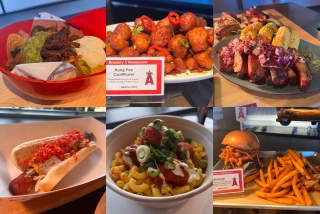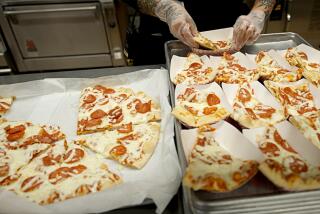Getting Hospital Food Off the Critical List : Doctor’s Essay Pans Menu, but Institutions Are Striving to Improve on Limited Budgets
If the hospital is known to have an animal research facility, skip the meat loaf. It is best to avoid any sliced object stamped “Dr. Scholl’s . “
--From an essay by Dr. Roger Smith, associate professor of obstetrics and gynecology, Medical College of Georgia
Dr. Roger Smith remembers the night pretty well. He was having another awful dinner at some typically loathsome hospital cafeteria.
Characteristically, he doesn’t remember what he ate. But that’s consistent with Smith’s long-held belief that virtually all hospital food is eminently forgettable.
He Wrote It Down
What’s significant about that night months ago was that Smith decided to collect on paper his various thoughts about hospital food--accumulated since he got out of medical school in 1972.
A medical journal published Smith’s little essay a couple of weeks ago, and, if the reactions of dietitians in Southern California health centers are any indication, the piece is precipitating chuckles in hospital kitchens all over the country. But, these dietary experts note, anyone who would go to a hospital for the food really must be sick.
It would be an understatement to say that anyone who has ever tasted hospital food will feel some solidarity with Smith’s position--a word he himself might choose to describe the texture of much of what he has eaten in the last 14 years.
Among Smith’s observations:
- “Beware of cafeterias with large signs advising the staff to wash their hands after handling the food. Avoid those facilities that have a pharmacist in attendance.”
- “Salads with a slightly ‘furry’ texture will . . . hold more dressing. (Salads) that appear to be growing something of their own should generally be avoided.”
- “Most people find that pasta-containing casseroles give new meaning to the phrase ‘bland diet.’ Hash-brown potatoes are often useful for removing stubborn stains from sinks.”
- “Remember that turkey Tetrazzini was named after its inventor. There is only so much you can expect ketchup to do. Skip any meat patty that floats (or) any soup that foams.”
Nancy Neff chortled. “I don’t think anybody would take this too seriously,” she said. “One problem with food is that everyone thinks they know something about it. They don’t all know something about medicine. So the food is a natural scapegoat in a hospital.”
Neff should know. She’s chief clinical dietitian at Huntington Memorial Hospital in Pasadena, one of a handful of health centers in Southern California that have tried in various ways over the last few years to put more zip, zest and zing in their meals--all under budgetary pressures that at Huntington require that the total cost of feeding one patient for one day not exceed $21.
Competing for Patients
The new food consciousness is not entirely an altruistic pursuit.
Audrey Sullivan, a dietitian who works for the Hospital Council of Southern California, said this represents perhaps an unnoticed--but nonetheless vital--aspect of marketing programs that the nation’s medical centers are being forced to employ as hospitals compete frantically for patients.
Food--once taken more or less for granted or accorded a low priority in the average hospital operation--has acquired far greater importance.
At Huntington, dietary officials have gone one step farther than simply making wine available (with a physician’s approval only) with lunch and dinner--one of the most common and noticeable steps in hospital food service of late. The brand: Embros--not something a sommelier would find captivating.
Huntington, though, even offers a special champagne dinner for each obstetrical patient and her mate--served the night before the mother is to be discharged. The meal is announced by an embossed menu and features shrimp cocktail, broiled filet mignon and a croissant. Cedars-Sinai Medical Center offers the purported equivalent of haute cuisine to some patients in a special wing featuring luxury rooms--a hospital service targeted and marketed to the decidedly upscale.
In recent years, both Memorial Hospital of Long Beach and Presbyterian Intercommunity Hospital of Whittier have hired chefs and though Presbyterian Intercommunity gave up on the idea after the second of its two chefs quit, Deborah Barker-Benfield, the hospital’s chief clinical dietitian, said wine service has enhanced a generally well-received food program.
And, despite everything people say about hospital food, Barker-Benfield noted, Presbyterian Intercommunity consumer surveys consistently have established that 90% to 95% of all patients and their relatives give the food high marks for quality.
Eight Styles of Same Dish
Hospital meal service is a difficult field, Sullivan said, noting that the average hospital must have as many as eight versions--regular, low-sodium, high-fiber, low-calorie and the like--of each dish.
At Huntington, which serves 75,000 meals a month to patients occupying its 565 beds, visitors, doctors and employees, Neff said patients eating the regular diet may find themselves served canned, frozen or otherwise prepared items like salad dressing and barbecue sauce while hospital chefs make other versions of the same things from scratch for people on restricted diets.
Like most hospitals, Huntington is moving to emphasize fish and chicken dishes and uses its daily patient menus for nutrition education. The hospital no longer uses salt, butter or margarine on vegetables. While most of the hospital’s food (30,000 pounds of meat, chicken and fish alone every month) comes from institutional sources that are decidedly non-gourmet in nature, Neff said hospital food workers often are sent to purchase menu items at Bristol Farms, a local gourmet market, for use in special diets or just to pep up things.
But Neff accepts the fact that no matter what happens in the kitchen that supplies both the hospital cafeteria and patients in their rooms, the popular notion will be that the cuisine isn’t much better than swill. She knows better, so she was able to chuckle frequently as she read Smith’s good-natured diatribe in the journal Obstetrics and Gynecology.
Is It Plastic or Food?
“If you cannot tell if the pie has been covered with plastic wrap, or just looks that way naturally, make another selection,” the Smith essay deadpanned. “Most hospital cookies are best used to level uneven table legs. Beware of the small lump of off-white topping found on . . . puddings. They have been known to fall off and cause injury.
“If there is a sign that reads ‘Fresh Ground Coffee,’ be sure to check for seeds and grass clippings. If the urology ward is located near the cafeteria, do not take the iced tea. Milk . . . should be chosen only if the expiration date on the carton contains the year.”
Smith emphasized that his criticism was directed at the cuisine in hospital cafeterias--noting that there is a great deal of variety in hospital food operations, with some serving the same things to patients as are sold in cafeterias. Some hospitals permit and encourage ambulatory patients to eat in the cafeteria and others restrict it. But hospital food, he said, is pretty much hospital food wherever and by whomever it is eaten.
In a telephone interview from Augusta, Ga., Smith said he remembers only one good hospital meal. He ate it at Carle Foundation Hospital in Champaign-Urbana, Ill., but he doesn’t remember what it was or when he ate it. He says that either says a lot good about the food at the hospital or underscores the fact that the Champaign area in general is something of a gastronomic wasteland.
The Meals ‘Blend’
“I obviously have not had a chance to try every hospital in the country,” he said. “I have had passable meals. They blend together. But, let’s face it, if you’re going out for a fine meal, you are not going to seek out the hospital.”
He joked that now that he has gone public with his feelings about hospital food he may have to enter hospital cafeterias wearing a disguise. “I have not yet received any bomb threats,” he said.
Besides, Smith said, he can’t be on worse terms than he is with doctors who travel around giving lectures to their colleagues since, two years ago, he wrote another little essay setting out instructions on how to sleep through such speeches without being caught.
“This (the new food essay) had to be written so it wasn’t malicious,” he said. “Face it, when you eat in a hospital, you’re willing to tolerate food that can simply be swallowed.”
tray, page one






